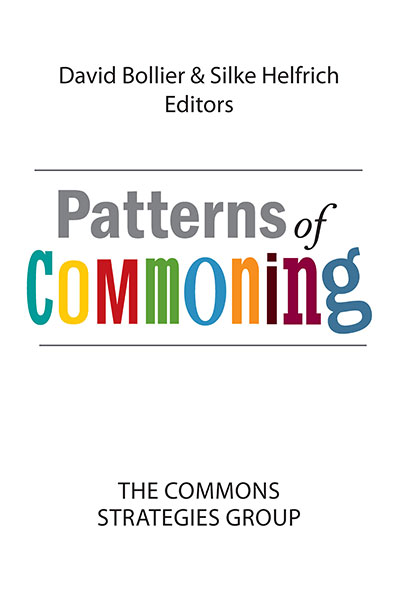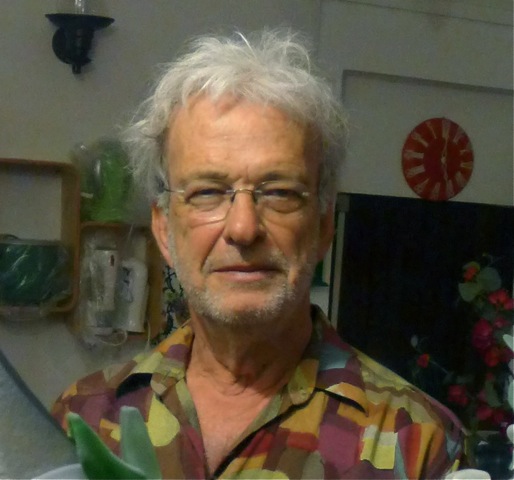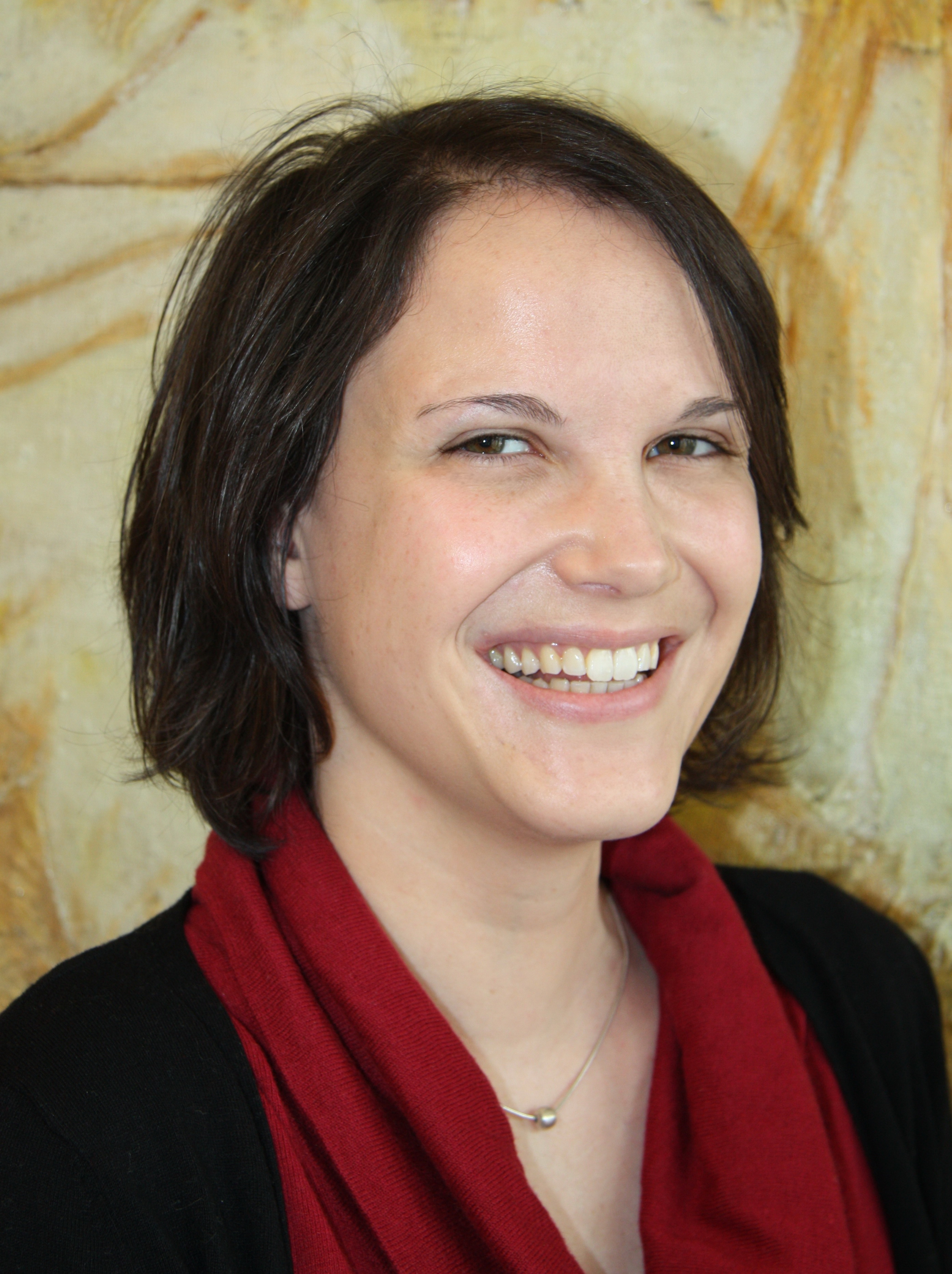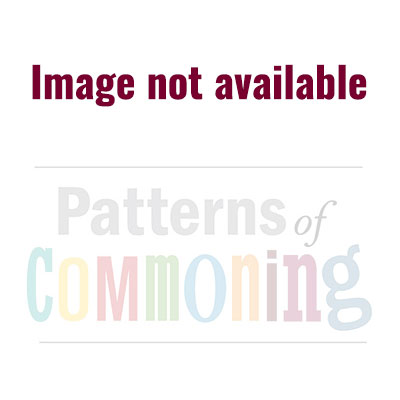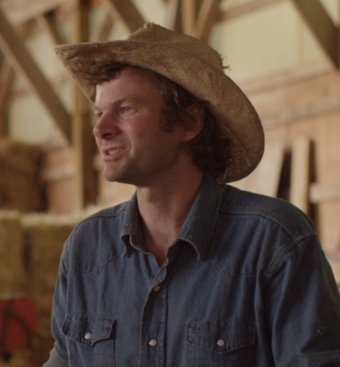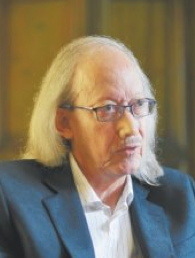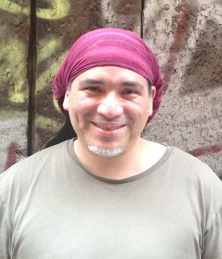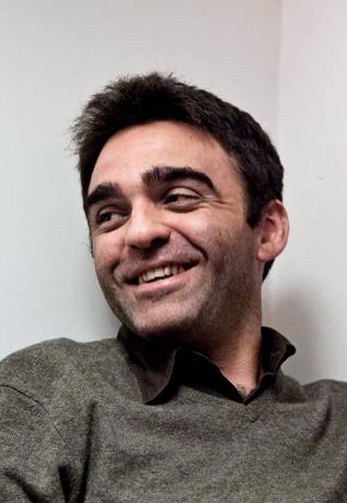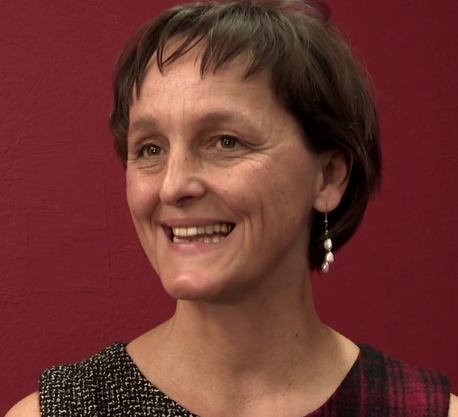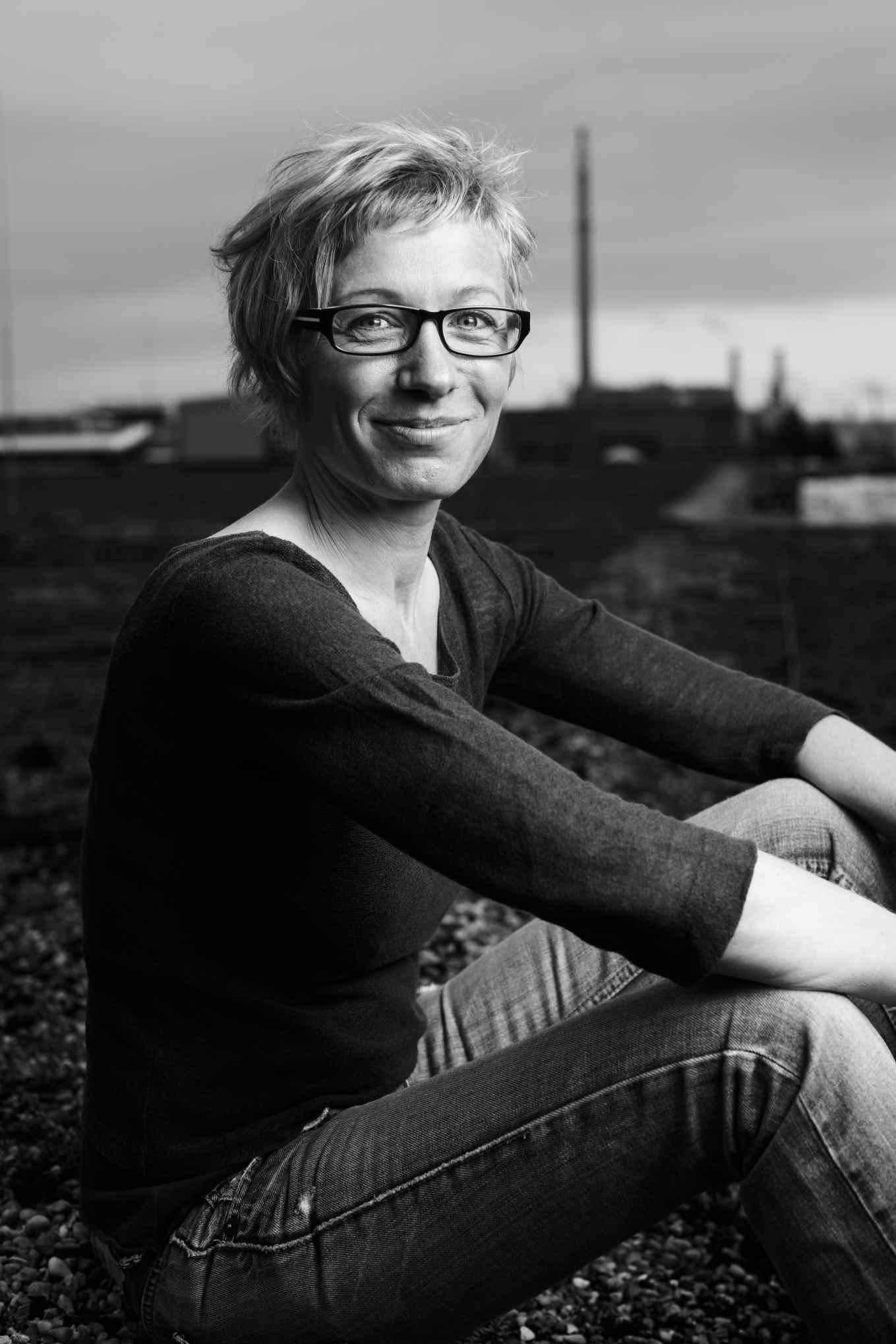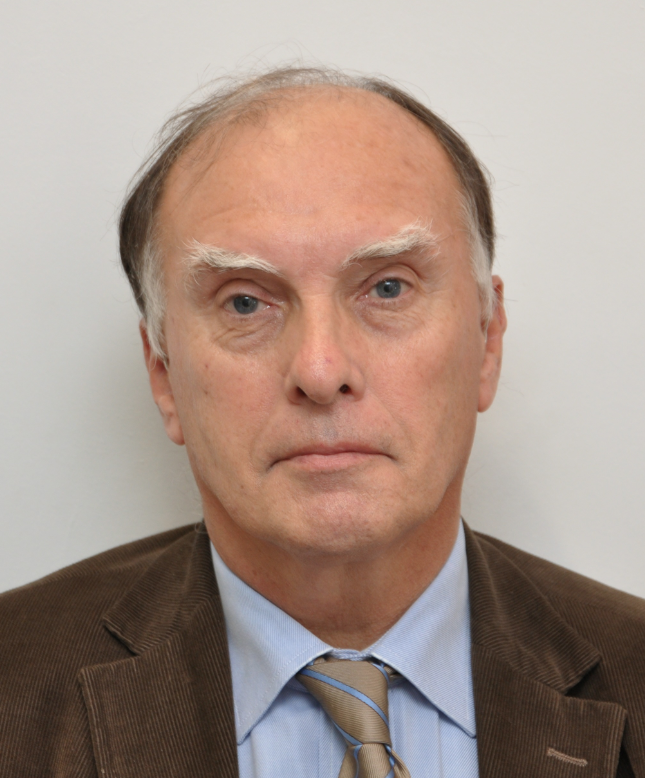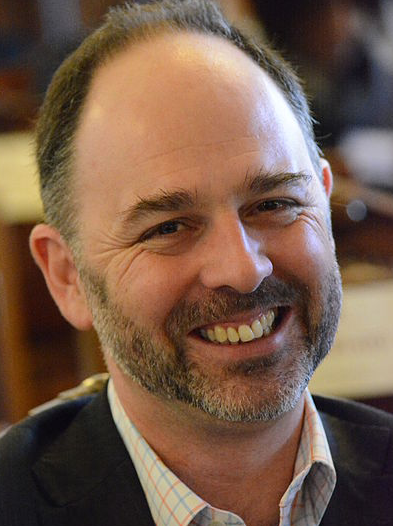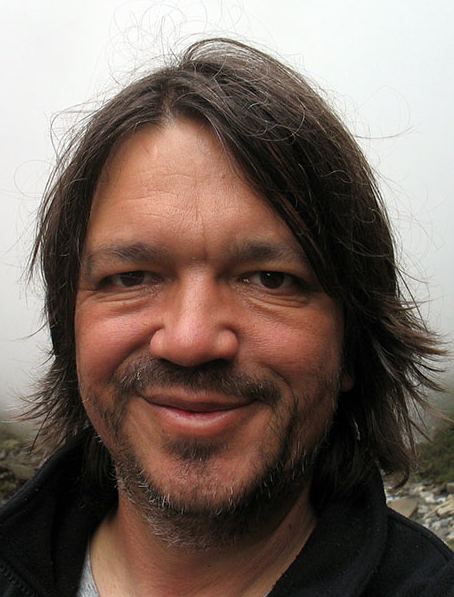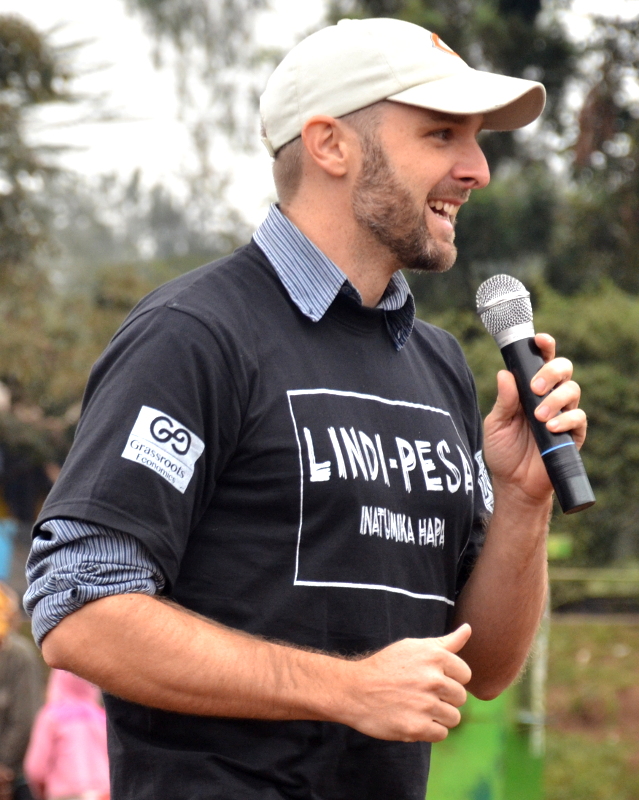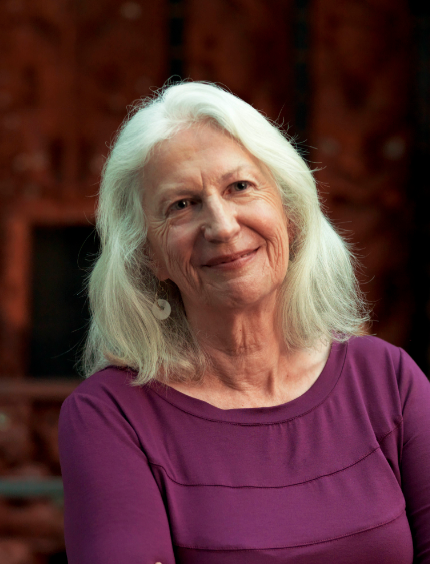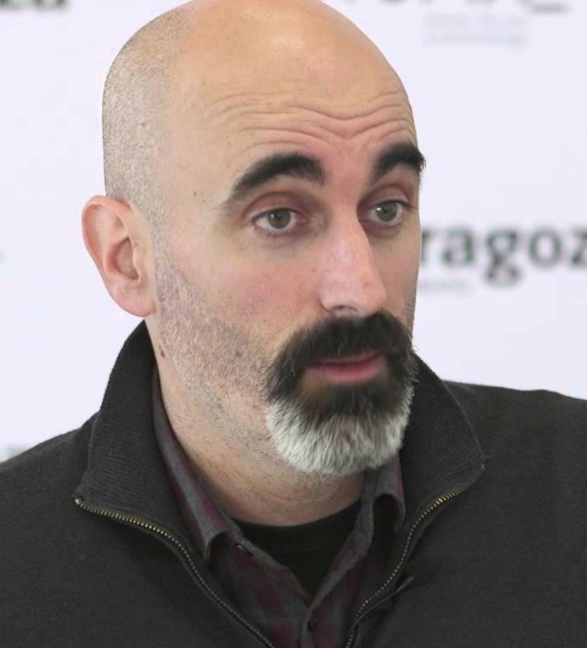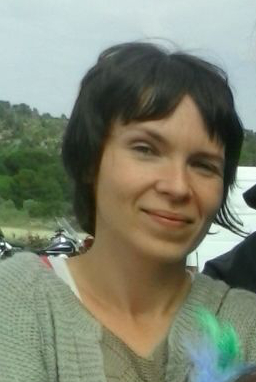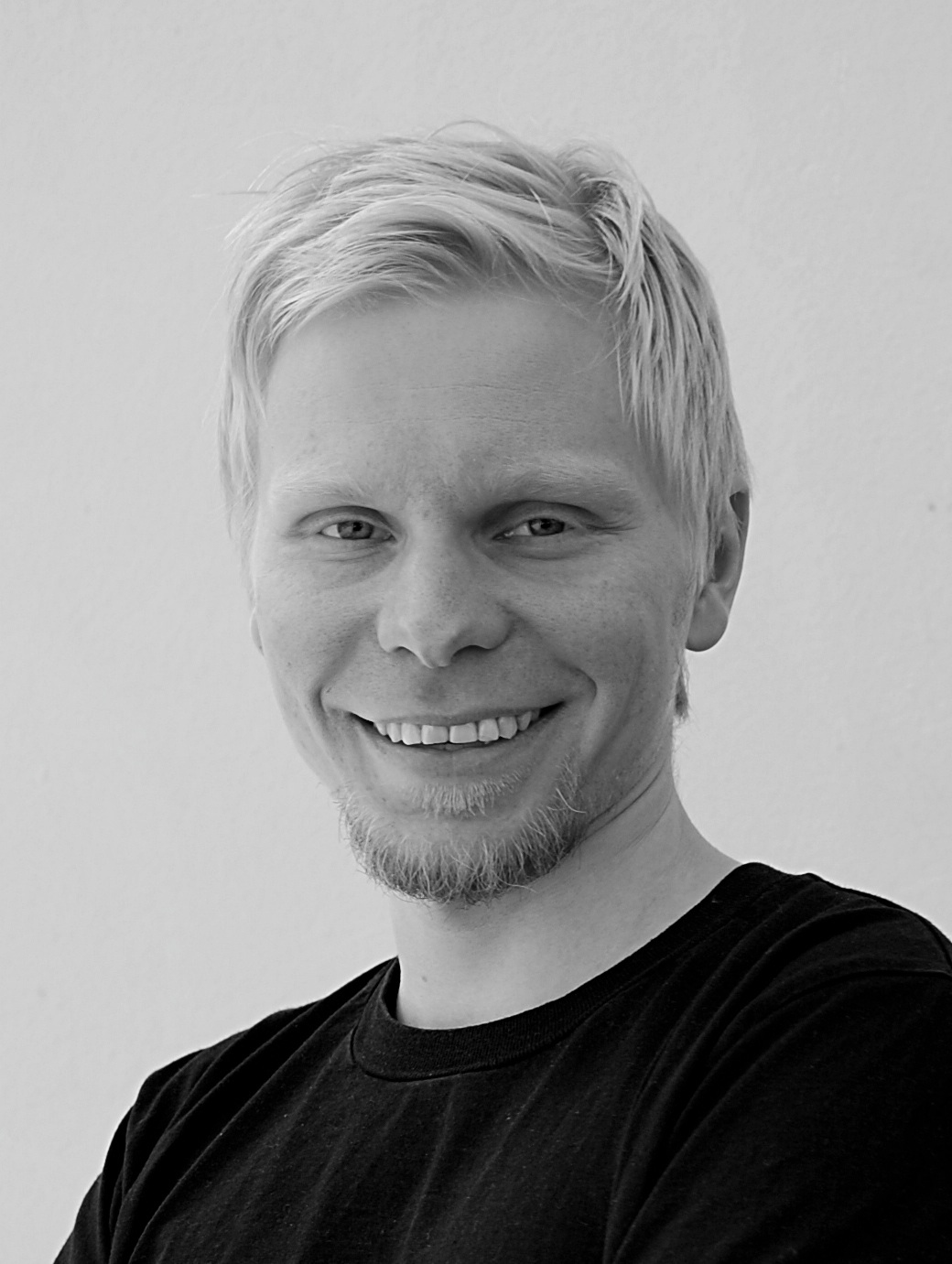Alain Ambrosi (Canada) is a designer and producer of intercultural projects, independent researcher, author, videographer and producer of the Remix The Commons Project.
Patterns of
COMMONING
Patterns of Commoning: How We Can Bring About a Language of Commoning
By Silke Helfrich1
The neighborhood I live in still sleeps and works according to the rhythm of companies that earned their reputations in the nineteenth century. It’s very late at night. A chat window pops up on my computer: Helmut Leitner is still awake, too. He had spent three months working through our volume The Wealth of the Commons: A World Beyond Market and State (2012) to “arrange and piece together eighty articles on the commons like a puzzle,” according to the chat log. Months later, in January 2014, I meet Helmut Leitner for the first time at a conference in Vienna. The abstract of his talk – “Patterns of Enlivenment” – catches my attention: “Pattern languages and a bit of theory [enable] holistic thinking in the service of enlivenment, transparency, participation, and sustainability.” Even more enticing, Leitner claims that a “set of instructions for dealing with cooperative forms of economic activity and life” could be fleshed out, drawing upon the insights in our volume on the commons and other sources.
At first I am skeptical about the description of pattern languages as “sets of instructions,” since I believe that Christopher Alexander’s approach offers far more to commons theory than merely being a concrete manual for collaboration in social spheres of a manageable size. After all, Alexander calls for designs that foster enlivenment: living cities, living communities, a living democracy; and ultimately he also calls for a science of enlivenment that disengages natural sciences and some social sciences from the metaphor of the machine. Alexander works toward a paradigm shift – from thinking about individual components that are separated from one another, toward thinking about the richness of relationships among loosely connected components. His pattern language discourse does not focus on what separates things, but on what connects them, i.e., he helps us learn to see living organisms embedded in a rich field of connections.
Patterns Make Us into Commoners
Patterns are usually revealed through processes that highlight the role of purpose, genesis, subjectivity and meaning, which reductionist approaches far too often neglect. Just as water is doubtless more than the combination of two hydrogen atoms and an oxygen atom, so are commons more than the combination of resources, communities and rules. The insight on which this book is founded, that commons do not simply exist, but are created – “There is no commons without commoning,” as Peter Linebaugh says – sheds light on why a deeper understanding of commons requires an approach that is capable of taking purpose, genesis, subjectivity and meaning into account. What is more: through the process of taking such an approach and pondering patterns of commoning, we change our understanding of ourselves in specific ways. Or to modify Linebaugh: There is no commoner without commoning. Becoming aware of the patterns of commoning gives us more clarity in thinking about commons and our identities of living within them.
All this explains why the pattern approach sketched out by Helmut Leitner in the previous essay is suitable for getting to the bottom of the idea of the commons while at the same time making it easier to communicate how commons can succeed. A pattern approach…
-is context-related (cultural, political-economic, social, and ecological contexts);
-is based in concrete livelihoods;
-supports self-reflection;
-generates experiences of resonance;
-recognizes one’s own experience as a pathway to insights; and
-has no predetermined outcome.
A patterns approach permits people to orient themselves to complex and dynamic systems, and can be applied to (smaller) community processes as well as (larger) societal ones. Patterns of the former are more specific, of the latter more general.
In June 2014, half a year after encountering Helmut Leitner in Vienna, I am sitting comfortably beside a raspberry bush in the lovingly tended garden of the Culture Nature Farm in Bechstedt, Germany. It was the third Commons Summer School, which included a workshop on “Patterns of Commoning.” We had already placed the concept of commoning at the center of our deliberations, so that the participants were already aware of the fact that commons are made.
General and Specific Patterns
The relationship between “general/higher-level” and “specific/lower-level” patterns can take on at least two forms:
1) Spatial/inclusive
For example: A commons project includes “self-determined rules” as an indispensable component. “Commons project” would be the general/higher-level pattern. “Self-directed rules of a commons project” would be the specific/lower-level pattern.
2) Abstracting/general
For example: The dual control principle (second pair of eyes) is to be found in various specific action situations – in bookkeeping, aviation (pilot/co-pilot) or politics (President/Vice President) – and it is less general than a backup principle, which is to be found in nature (our two eyes, ears, and kidneys, for instance) or in technology (backups of files).
But this insight did not answer the question: How? After all, at times it seems more difficult to “do commons” than to “imagine commons.” Yet the more (often and intensively) we ponder this question of how to common, the more often our thinking departs from conventional schools of thought, including, ultimately, institutional economics, and enters uncharted territory.
Commons Theory on a Multilayered Foundation
Political scientist Elinor Ostrom’s design principles for commons institutions (see p. 47) have become widely known ever since she was awarded the Nobel Prize in Economics in 2009. Ostrom was largely concerned with “diverse institutional arrangements for governing common-pool resources (CPRs) and public goods at multiple scales” (Ostrom 2010:641, emphasis added). Her method was based on the standard frameworks and concepts of institutional economics, but – and this is her special accomplishment – she focused on the fact that the arrangements sought are not to be found only in a dichotomous choice between the market and the state. This well-supported insight is a point of no return, both in political and scientific terms. As an empathetic, dyed-in-the-wool academic, Ostrom sought to understand the “broader institutional regularities among the systems that were sustained over a long period of time and were absent in the failed systems” (Ostrom 2010:652). She, as well as other schools of thought on the commons on which she had a formative influence, used the Institutional Analysis and Development (IAD) modeling (see Figure 1).

Figure 1: Basic components of the IAD framework, as outlined by Ostrom.2
It serves to analyze situations in which people are confronted with various demands, norms, and rules, some of which are contradictory (Conway 2012). Such contradictions are part of everyday life. Everyone is familiar with them – for example, the criterion of individual “mobility” in order to be available “for the labor market,” which requires that you have a car to be available for where and when you’re needed. This privileged criterion, however, affects one’s usage of public transportation and even its being provided in the first place: the more people who use their own cars in a certain area the less sense it makes to sustain public transport services.
At a more abstract level, IAD modeling is complemented by the Social-Ecological Systems Framework, which is based on numerous variables that constitute a whole social-ecological system and is therefore included in the analysis of a commons. Taken together, IAD and SES form a kind of double analytic system that consists of groups of building blocks (or “variables”, see illustration) – such as biophysical conditions, characteristics of the community and rules – that affect the concrete “action situations.” Although this approach is quite detailed and differentiated, it ultimately clings to the notion that changing the number and quality of these analytic building blocks affects the desired result more or less directly, as if one were causal to the other.
Of course, some things do cause other things. Nonetheless, the dynamics of a commons cannot be captured by an input/output calculus; there is more going on than causality. Likewise, the “ingredients” that constitute the system matter. An outstanding meal cannot be prepared using inferior ingredients, and conceiving education as a market activity oriented toward the requirements of “the economy” that is driven by grades and test scores cannot bring about a well-rounded, socially concerned human being. So, too, commons do not result simply by combining certain rules and building blocks; they can hardly emerge, for example, from rules that are inimical to commons or from groups of hard-core loners. The sum of building blocks does not constitute the whole because integrated systems have their own, larger logic. Both are important ways to understand commons, but one must recognize that the conceptual framing of the commons that I as an observer propose – i.e., the “how do I imagine commons?” – in effect predetermines what will be analyzed and perceived in the first place. In effect, one’s analytic categories constitute one’s understanding of the commons. If education is conceived of as a commodity whose primary function is to serve the labor market, for example, it will hardly seek to “transform as much of the world as possible … into oneself,” as Humboldt describes the proper scope of education. Or people who think of eating only in terms of providing calories will not necessarily set out to find fresh foods.
In short: The way in which we imagine and model a system has a direct bearing on how we conceive its creation, structure and character.
So commoning does not simply succeed when all the factors and conditions have been optimized and all institutions comply with the stipulated design principles. Ostrom herself emphasized that ultimately there is no reliable chain of cause and effect. Yet we can address this “gap” in causality by complementing Ostrom’s Law with a holistic approach that is capable of incorporating the characteristic of social processes that have their own meaning and purpose.
This is where I locate the potential of pattern theory for commons theory. While suitable institutions can provide frameworks for cooperative institutions, patterns of commoning contribute to developing concrete skills within these institutions, providing sharper definition to the as-yet undertheorized concept of commoning. It is important to address the internal, intersubjective dimensions of commons because abstract terms detached from concrete practice are not well-suited to communicating dynamic social phenomenon that have many of their own idiosyncrasies. This problem can be countered by patterns of commoning. Patterns have the potential to capture the principles and inner dynamics of self-organization, helping to make them more easily reproducible and able to bring about a more profound social-ecological transformation. Patterns theory does not insist upon strict causal relationships; instead it helps identify the subjective, contingent complexities of any commons. Here, patterns can be seen as structures within which things crystallize so that commoning can develop in as many different spheres and on as many levels as possible.
The basic point: Ostrom’s approach should be enriched in the medium term by two complementary tools: a pattern language of commoning, which this article attempts to outline, and a pattern language of a “commons-based society,” which has yet to be developed.
Patterns Make Commoning More Effective
Helmut Leitner’s effort to assemble descriptions of commons projects like pieces of a puzzle and to comb through them, seeking out patterns, is worthwhile because it makes commoning more effective. That is why we are sitting in the garden in Bechstedt and jointly developing patterns on the issue of “borders and exclusion in commons;” Who’s inside? Who’s outside? And why?
That is why I host another workshop a few months later in Montreal, Canada, where three dozen people from projects, networks, universities and public agencies debate the art of commoning3 in general and develop patterns for conflict resolution in particular. The event prompts me to reflect on a very classic problem of collective processes – “sharing of costs” – from the perspective of patterns. This perspective lays bare the connections between processes that appear all over the world in specific forms that vary based on time, location, environmental and social conditions, as well as people’s sensitivities. All these processes harbor patterns, the hypothesis goes, and laying them open not only helps us to understand the processes of commoning, but also facilitates their integration into everyday life and institutions. Not in the sense of a how-to manual or a “set of instructions” for commoning, but definitely in the sense of a catalyzing action and reflection. The more commoning seems normal to us, the more easily and effectively the various commons – the “peninsulas against the current,” in Friederike Habermann’s words – can be networked with each other, and the more intensively they will support societal transformations.
So, how can such patterns be developed?
Valueless Patterns
The creative cycle of pattern generation, as outlined in Figure 6 in Helmut Leitner’s chapter, amounts to a reflexive practice for problem-solving. This creative cycle is initially independent of ethical or moral meaning, but it gradually becomes endowed with values as people generate, exchange, test and change them in everyday interaction with each other.4 It is this performative creation of meanings that generates values in a community. One could call this creative process the essence of commoning. In other words: We act, and through our actions, we generate the criteria and standards through which we can ascribe value(s). Values are understood here as an expression of creative energy and imaginative potential for action; they are neither objectively nor categorically determined by anything in particular; they are developed anew each time that commoning occurs, again and again.
Accordingly, values do not exist before commoning as some kind of predetermined blueprint. There is no god, no state and no purportedly objectifying process that can set the values of a commons in advance. And yet, from a commoning perspective, values become an essential element of successful commons that patterns of commoning must take account of. In the process of developing patterns, one must therefore ask over and over whether a value so elementary to the commons as “freedom based on relatedness” 5 is strengthened or made vulnerable.
To enter into commoning is to search for patterns that help to shape our way of living together as voluntary experiences, free from external coercion and constraints. Free cooperation as a basic principle is not only for small size communities; all of society can ultimately only be maintained if in principle cooperation can also be taken away or given up. In simpler words: People must also have the option to leave a group, or to “exit.” There can be no justification for forcing cooperation.
In commoning, as in all social processes, successful solutions can be replicated only to a limited degree. Needless to say, there are no silver bullets. So patterns remain a means of showcasing commoning in such a way that the salient, constant features become visible without having to banish certain other features from reality or ignore contextual elements. It goes without saying as well, that many of these patterns are right in front of us, they are just not well articulated in language or made culturally legible. As Franz Nahrada, an expert on pattern languages, has put it: “It simply isn’t the case that pattern languages are something fundamentally new; they are implemented so naturally in our lives that we probably wouldn’t even have found out what is actually essential if they weren’t threatened so strongly by many, many negative societal developments. So we have to act with a special awareness to reconstitute these ‘natural’ behaviors.”6 This reconstitution comports with Elinor Ostrom’s understanding of her work as identifying the conditions for cooperation to flourish. Her question was not whether people want to cooperate, but rather how to help them do so.
Developing Patterns
Fostering cooperation, helping to make commons: that is what patterns can achieve. Combined in a pattern language, they orient us as we search for the structural elements for creating solutions for commons-related problems that work in particular contexts. Patterns let us assess the productive potential of different prospective solutions and compare them with each other (Transition Network 2010). The process of developing them should be understood not as abstract knowledge about the success of commons, but rather as practical, accessible knowledge about how to solve very concrete questions of concern to the networks or peer-to-peer communities on electronic networks. Patterns stimulate focused reflection. The knowledge created in this way directly influences the actions of commoners and shapes the contexts of their future activities. Patterns of commoning can promote the basic openness of a process, help guarantee that everyone involved is actually part of the discussion and decision making, and raise the question again and again: How does this process support everyday needs and the enlivenment of life?
One of the most important features of every pattern language is to not see it as a model, but as a platform that enables us to take the first steps in adapting specific patterns to our own particular circumstances. A pattern language is necessarily incomplete knowledge, but still it represents the best knowledge that we have and it can be further developed jointly as needed. People familiar with developing patterns know that the process helps elicit insights that “we already know” deep inside but which have not yet been made visible and explicit. The patterns shed light on the conceptual foundation of commoning and give them a clear formulation that makes it more comprehensible to outsiders and thus more easily replicated.
In the best case, a pattern is to be formulated in a language appropriate to the respective subject matter – in our case, commoning, it must be a language that is itself open and that remains enlivened. This way, a pattern language of commoning co-creates a common language of commoning – one that not only lets commoners see the hidden social logic and practices that hold them together, but also helps communicate key commoning themes that shed light on the similarities between (for example) community seed banks and free software, both of which seek to protect their shared resource against enclosures. Again: Patterns are above all a pattern language: a means of forging community and socialization par excellence.
During the development of each pattern (language), the question first arises: How to start? How to “set foot” in a system with so many details and contextual complications and begin to systematically analyze it? Some ways of accessing it are summed up here:
How to start? Methods of developing patterns
7
-Brainstorming
-Text analysis of descriptions of commons projects and commoning processes
-Derive from categories and key concepts of the field to be examined (specialist literature)
-Elicit patterns through internal discussions by commoners
-Examine meta- or general patterns to deduce specific patterns (see box above)
-Look to patterns from other pattern languages for inspiration
-Test alternatives to already existing patterns
-Extrapolate from scientific discourse about particular patterns
-And others yet-to-be-discovered.
In other words: many paths lead to the creation and identification of patterns: By looking more deeply at projects, we can draw on tried and tested practical examples and the knowledge about problems specific to the commons. Processes of communication, cooperation, mediation, and conflict resolution in other areas of society may provide useful material for developing patterns. We can also study the repertoire of methods of social innovators and movements – permaculture, transition, nonviolent communication, systemic consensus-building, “Scrum” agile project management8 and many others – to identify patterns that have already been developed. (See example below.)
Patterns inspired by other pattern languages: Iteration and Iterator
Iteration
From the pattern language: “Groups work: patterns enlivening human encounters.”
Description: If at first you don’t succeed, try again a second or even a third time. The outcome of the first round of an activity or conversation will inform the next round and will deepen, broaden, and generate new understanding and new possibilities. To achieve a stronger effect, repeat a process several times or come back to it later.
Example: At the beginning of a group meeting lasting several days, you will presumably feel alone among strangers. Halfway through the meeting, some faces will be familiar, and you may have forged some relationships. By the end, you will probably feel more integrated into the group. Every day is a new iteration, whereby you always start over from the beginning, but at a higher level each time (from Group Works Deck)9
Iterator
Description: Software developers use iterator patterns in programs to access elements of a set, or put more simply: a list. Iterator patterns operate according to the basic principle: “if there is another element on the list, then provide it.” Iterators are usually generated by a code function called “iterator()”.
Example: Iterator pattern in the programming language Java: Every Iterator pattern makes functions called next(), hasNext() as well as an optional function called remove() available. An iterator pattern outputs a special value that marks the beginning. That is why, after initialization, the function next() has to be run first, which marks the first element of the list to be searched. The function hasNext() is used to find out when the program has arrived at the last element. The following example shows a simple case of using iterator patterns in Java:
Iterator iter = list.iterator();
//Iterator<MyType> iter = list.iterator(); in J2SE 5.0
while (iter.hasNext([/efn_note]{
System.out.println(iter.next([/efn_note];
}
To illustrate: This is like reading a text following these instructions: “If a word follows, then read it and show it on the monitor. If no word follows, you have reached the end of the text and completed the task.” In each step of accessing the text, called an iteration, exactly one word of the text is available for processing. The entire text can be processed in many iterations. An algorithm described like this is so abstract that it can be used in many situations, for example, iteratively working your way down a street, looking at the sewerage connection of each and every house, or working your way down the questions on an exam. (Source: Iterator, https://de.wikipedia.org/wiki/Iterator)
The first patterns of commoning that I would like to present here were developed to address typical problem areas of commons. Normally, sufficient inspiration for developing patterns during a workshop (as we did) can be gained by using people’s own descriptions, practical experiences, and knowledge as a jumping-off point. At the beginning, the context and the problem(s) in a concrete action situation are defined as precisely as possible. Then, everyone jointly focuses on one problem or one aspect of it. In a sense, it’s just circling around the identified problem in a conversation collectively. The basic idea of this approach is to first open the floodgates and present all the solutions that the people involved can contribute from their experience and their imagination. This prepares the ground for things to emerge that were previously unimaginable.
At first, it is important not to pursue a single idea for solving the problem, but instead to keep asking the questions: “What else is there?” “And what else?” “Which other solutions are imaginable?” In this way, the elaboration of patterns takes place step by step, and also iteratively in each and every phase of the exploration. During such a conversation, the abundance of our ways of managing a situation and shaping our social realities and devising solutions to common problems becomes more visible, while the limits of each possible solution are sketched out too. In short: The procedure remains anchored in immediate, practical issues.
Patterns of Commoning
Celebrate and celebrate often. Celebrate the small things and
celebrate the large things. Celebrate failure (and success!)
From the Transition Network’s collection of patterns (2010)
In the course of connecting various perspectives, there often comes a moment when a group develops a confidence and conviction about a pattern – that describes a common reality shared by all. Co-intelligence scholar Tom Atlee would call this moment “collective magic.” One workshop participant, while thinking about agricultural commons, formulated this idea in these words: “I had a new thought every time someone spoke. Now I feel I’m not thinking only about rules and structures, but about the people. People sulk sometimes. Structures don’t.” Indeed: and this has to be taken into account. People have emotions, in each and every commons there is an emotional memory. Pattern theory relies on this insight: patterns permit people to access not only the rational approaches to a topic, but also the emotional ones. In this way, they activate the experience of collective resonance, which is often experienced as magical.
While Ostrom’s design principles delimit the normative horizon of institutional design, patterns can make accessible what happens within these “institutions” and at their borders. They help elicit answers to questions such as: How do people make sure that nobody feels taken advantage of? How do people deal with power and dominance within a commons? How can discrimination on the basis of gender, ethnic group, ability, descent etc. be addressed? How can the commons succeed in everyone contributing what they can? And how are commons protected from enclosure or reprivatization – in the midst of capitalism?
Beginning with an answer to the last question, I will introduce four examples of patterns of commoning. The structure that I will use to describe them resembles those Helmut Leitner introduced in his essay.10 Recall that it consisted of a series of items that move from context → problem → solution → result → specific pattern name →related patterns.
Case 1: The Logic of the Commons vs. the Logic of the Market
The Context
Real estate markets treat buildings and land like any other commodity, which frequently results in speculative investments that drive land prices and rents up, making housing unaffordable for many people. To address this problem, a network of residential projects across Germany, the Mietshäuser Syndikat, devised a decentralized organizational structure in an ambitious attempt to “claim apartment/residential buildings as commons” (Rost 2012:285).
The Problem
Just as the situations of individual people living in residential projects change in unpredictable ways, so do societal conditions. Project finances can fail or the transition to a new generation may bring unforeseeable challenges. A building purchased jointly decades ago can become more valuable on the open market, making it seem attractive to sell it. In all these cases, the building, which had been deliberately removed from the sphere of the market, could now be returned to it. To preclude such a possibility, a building association could lay down in its bylaws, that residential property is to be permanently removed from the market. Yet the people involved in the association could still change their bylaws with a qualified majority. So the governance provisions don’t seem to be secure enough to protect the property as a commons in the long term
The Solution
Most but not all of the residential projects organized in the network of the Mietshäuser Syndikat are set up as cooperatives: therein, an assembly of all tenants (“association of residents”) decides democratically, within the framework of its bylaws, how to make the best use of its respective building, how to manage it, oversee construction projects and secure financing. In other words, the respective association or cooperative of residents settles all matters that are linked to managing the collective property as such; however, it does not decide by itself, how to resolve questions relevant to ownership, such as sale of the property. This is made sure through a simple legal construction: The title of ownership for a particular collective property is not in the name of the property’s association of residents only, but it’s with a classical limited company. This limited company has just two partners, the association of residents and the Mietshäuser-Syndikat itself, each of which has different interests. In the event that a decision to sell needs to be made, there are only two votes – one from the association and one from the Mietshäuser-Syndikat. The property can be sold only if both bodies agree, which essentially gives each a veto over a proposed sale. This simple concept relies on both a classic separation of powers and the principle of consensus.
The Resulting Situation
This legal scheme raises the institutional barriers to re-privatizing and selling housing that was conceived of, created, and financed as a permanent commons. At the same time, this solution does not entirely rule out sale of the property, which may prove reasonable in individual cases. In the event that it has to solve problems relevant to the bylaws, the association or cooperative of residents receives support from the Mietshäuser-Syndikat.
The Patterns
Protect commons from the logic of the market
Use a trusted entity for strategic co-decisions.
Case 2: The Relationship of Give and Take
The Context
Among the members of a German community-supported agriculture (CSA) project, there is a broad consensus that giving and receiving should be decoupled from one another to help achieve structural change in the economy, society and their own organization.11 As a community within an EU “model region,” this CSA is eligible for support for experiments in alternative forms of economic activity, a general situation that provides favorable conditions for launching new ideas and projects.
Some farms in the region have been working with this CSA. They practice organic farming, but have come up against limiting factors time and again, especially if they produce dairy products and meat in addition to vegetables and fruit. The problem arises between the CSA and one of the organic farms (which is not the common supplier of this CSA). Both value each other highly, and they both are even planning for the organic farm to become a partner in the CSA project.
The Problem
One standing challenge of community-supported agriculture is to make do with what is produced while spending only the amount of money raised from the CSA members at the beginning of the growing season. These two factors – what a supplier can produce and what the community can contribute – places limits on how much produce the CSA can supply year-round, a limitation that members generally accept. The concrete problem in our case is that the CSA, in 2014, needed more potatoes to provide to its members. So a CSA representative asked a nearby organic farmer and friend (not the usual CSA supplier) to donate the potatoes she could not sell to other customers to the CSA. The farmer, who herself is involved in many community-minded activities, says no – and the resulting argument took on a sharp tone: “That is a matter of principle. I’d rather feed the potatoes to the animals or put them on the compost heap. … If a potato doesn’t cost anything on the market, does that mean that a CSA organization can take it for free?” The CSA member replied: “To me, it is a matter of course that if you have something you don’t need, then you give it away.” And: “In the end, a “NO” means that you would rather let something rot away someplace, than give it to the CSA.”
The Solution
No solution is found to this conflict at the moment. But, when the people involved think about and discuss it later, it becomes clear that the dispute isn’t really about the potatoes, nor about giving away or selling, nor is it a personal conflict. The organic farmer concludes: ”It’s about sensitivities, about recognition. And it’s about the fact that I can make these decisions myself. Otherwise, something’s wrong.”
The Resulting Situation
The CSA has to buy potatoes elsewhere or meet its need in some other way. The farmer considers that to be a necessary learning curve for the CSA. Furthermore, when both sides have a conversation about this situation, it becomes clear that each has very different basic assumptions that were not properly understood by the other side. Both sides are interested in finding better solutions in the future. The key to do so successfully lies in the following patterns, among others.
The Patterns
Voluntariness is key.
“It’s about the fact that I can make these decisions myself. Otherwise, something’s wrong.”
Recognize explicitly the other’s contribution.
Related patterns
Disclose basic assumptions
Decouple the acts of giving and receiving
Value people vs. added-value
Create a sense of fairness for all
Case 3: Making Decisions Jointly
The Context
About thirty adults and thirty children live and work as a community in a rural setting. Most of the land is wooded, there are a few meadows and fields. As a rule, decisions are made by consensus, i.e., it isn’t necessary for everyone to vote “yes” every time, and people can support a decision passively, yet in principle they can exercise a veto. People like and respect each other. There are conflicts, as everywhere, but overall, they have a strong interest in inclusion and a lot of shared experiences as a community.
The Problem
The group has decided to go with a strict consensus, concerning whether to allow livestock farming in the community. That means: if somebody votes “no”, this person actually exercises a veto. Therefore, the very framing of the question (allow livestock farming or not) implies that people who wish to raise animals will be excluded even if only one person votes against the proposal.
At a certain moment, one woman congenial to the group has applied to become a member. The group in principle supports her application, but she wants to keep some dairy cows to support herself. Some members cannot back this decision even though they would like to welcome this individual as a new member. Not keeping animals is very important to them.
The Solution
One positive factor in finding a productive solution is the group’s many years of experience with consensus decisionmaking. That framework provides for four options:
Yes
Abstain
Agree, with reservations
No
The group decides to introduce another option:
Agree, with strong reservations
The Resulting Situation
Thanks to the introduction of the new option, three people who had maintained their vetoes for three years feel that their views are sufficiently taken into account. They feel they are now in a position to lift their vetoes and agree to admit a new member even though this member raises cows.
The Pattern
Expand options for decisionmaking
Related Patterns
Disclose basic assumptions
Case 4: Conflict Resolution Within a Commons Project
The Context
In a large building with many large rooms suitable for groups, rental payments are to be secured for several years by about thirty people (and potentially more users of the building in the future) on a voluntary basis. Members do not all know each other well, and the ways in which they use the rental property differ widely. Compared to market prices, the rent is low. Even so, the financial situation of most users is precarious. This makes it difficult to plan finances and maintenance. Everybody seems to assume that “somehow there will be enough money.”
The Problem
In order to make sure that the rent is paid on time every month, the group makes a joint decision about a recommended amount per person and month. This is then communicated a number of times by mailing list. But in principle, the contribution is voluntary and not mandatory. Each one is supposed to contribute according to what s/he is able to contribute. After a few months, the group is in the red. The problem is not solved by sending alarming e-mails to members informing them about the actual payments by individuals (without mentioning names). The precise reasons for deficit remain in the dark.
The Solution
In a conversation using a talking stick, everyone involved takes advantage of the opportunity to describe how he or she personally deals with the issue. This brings individual motives to light. In addition, some basic assumptions that had never been mentioned explicitly are formulated for the first time (“But that’s just a small amount per person.”)
The Resulting Situation
The group continues to refrain from requiring individuals from paying specific sums. Yet the deficit disappears. Talking about each and every individual’s feeling of fairness and at which point they “stop giving gladly” has raised people’s awareness on the complexity of the situation. People apologize to each other when they understand individuals’ other ways of dealing with the rent question.
One reason that many people mention for not increasing their contributions is their “individual feelings of fairness” → “It would no longer be what I’d gladly give.”
The Pattern
Making the invisible visible
Related Patterns
Transparent financial situation
Disclose basic assumptions
Create a sense of fairness to all
Talking stick
Many more examples could be described and tested against real-world experiences. In this way, one pattern after another emerges; they can relate to one another like words in sentences,12 connecting to one another, and finally growing to form a pattern language that is always open and adaptable to new conditions, just like the language we use. When we reflect on these patterns or develop them jointly, different levels of abstraction become visible. Some patterns can be used in collective processes of a manageable size; others describe a different societal logic, for example, “protect commons from the logic of the market” or “decouple acts of giving and receiving.” and “make the invisible visible.”
Of course, developing patterns won’t suffice; commons-friendly structures must also be developed to create the conditions and support the long-term persistence and proliferation of commoning. Such structural changes (through public policy, law, organizational forms, etc.) require political commitment for commons and commoning. Yet often the opposite occurs, intentionally or not – but always effectively.
Anti-patterns
In fact, many public policies or structural economic conditions today can be described as anti-patterns. Anti-patterns are “patterns” that are not adapted to the diverse individual needs in enlivened systems. Nobody would assume that a single model of shoes would fit everyone or that a single model of a house replicated millions of times would fulfill everyone’s dreams of their own home. It is also clear that not all students learn in the same way, or at the same time of day – and yet teaching is often organized in this way. The following excursus shows just how ubiquitous anti-patterns are.
Minimum Wage or Commoning?
A mandatory minimum wage – 8.50 gross euros per hour – was introduced in Germany on January 1, 2015. According to many, the law represents an attempt by the political community to set limits on the business community. This way of thinking follows the pattern “state versus market”. Actually, the minimum wage intervention by lawmakers seems plausible for situations (like the one we currently live in) with clearly defined roles: entrepreneurs and owners on one side, wage earners on the other. All too often, the latter can’t make ends meet because of their low wages. All too often, one side dictates conditions. This results in a never-ending conflict between interests with periodic interventions by the social welfare state as a way to smooth out contradictions that in essence stem from a segmented world where all too often others make decisions for us. In this world, producers are not only forced to compete with each other; an active life is separated into “work” and “life.” All too often, “working to earn money” crowds out any other possible motivations for work, including the idea of “working to live.”
In such a context, the minimum wage – which is supposed to create a minimum level of equality in formal terms – can never create a feeling of social justice.
Why is that? The minimum wage law applies to people who are very unequal in personal circumstances in a formally equal way. It applies to temporary employment agencies in the construction and cleaning industries as well as to railway workers, to asparagus and strawberry farms using a lot of seasonal labor as well as small farms and craftspeople’s businesses without internal hierarchies. During a discussion with organic farmers and people working in the sector, I hear that the minimum wage, which makes sense to them “in principle”, cannot be sustained in practice, especially on family farms where agriculture is a way of life, not “a job” and where people must work as much as necessary in a given day (during harvest time, for example). But the new law is very strict and detailed, farmers tend to come up with “creative bookkeeping” to comply with it, but nobody feels good about these petty subterfuges.
The situation is complex: Someone asks during the discussion, “And what if farmers went on strike, but not for minimum wage, but for a ‘skilled craftsman’s wage’?” Another one suggests a “minimum wage per day”? Would that be a pattern, with no upper limit on the number of hours worked per day? Isn’t this the same as just switching from an hourly to a daily rate? The actual living and working situations of the people who participate in our discussion vary immensely. The way they are affected by the minimum wage law varies as well. Yet everyone agrees on one thing: Such an approach has no room for a simple idea such as “working is enjoyable.” Reflecting on his own situation, one middle-aged man who has spent decades working toward different concepts of work and life reports how he observed himself starting to think about whether a farm worker “was productive enough for his hourly wage” – a thought he had never had before. The man lost sight of the idea of work as something integral to one’s life and even enjoyable. In such a context, having a chat on the farm loses its innocence and becomes potentially an issue to be sanctioned. The new setup changes everything; it highlights in a somehow tragic way that “clocking hours doesn’t really go with agriculture.” Similar dynamics apply to many other occupations – scientist and artist, artisan and mountain guide, geriatric nurse and physician. The list is endless. Counting and care don’t go together.
So, farmers and other sectors are experiencing how the formal equality created by a law that makes sense “in principle” generates new injustices. For example, a man who has taken early retirement may work a few hours per week on a farm on a 450 euros per month basis (in a special program according to which no taxes or contributions to the social welfare system are deducted), and in fact receive now 8.50 euros per hour gross under the new minimum wage law. Whereas, trained farmers or gardeners work 50 hours or more per week on the same farm until all the work that needs to be done is actually done and would never make 8.50 per hour. “You can’t ‘adapt creatively’ so many hours in the payroll accounting.”
“Can there be creativity in actual pay instead?” someone finally asks. The first answer comes from a communal farm in the Black Forest that has experiments with a different concept: no wages are paid, and yet everyone can live according to their abilities and needs. The basic idea of this farm is incompatible with the minimum wage approach. Instead, this farm cultivates the attitude: “Everyone makes their best effort, then we’ll have everything we need.” Formal equality is not an issue on that farm. For example, if there were two apprentices only one of whom had financial support from his parents, then “we would all decide together how to handle the situation.” As a result, it is “possible that every person gets a different amount, and still everyone agrees.” If two people have different needs and get the same amount, then one person has what s/he needs, and the other doesn’t. That would not be fair. The group succeeds with this different way of solving the problem. And their way is based on patterns of commoning, which should be made explicit so that these patterns can inform the decisions of others.
Conclusion and Outlook
There are many reasons that we need to develop a pattern language of commoning. Pattern languages are capable of finding the treasures within our implicit knowledge, which too often go ignored or unexpressed. Specific patterns of commoning will help us to get beyond counting and measuring everything and instead encourage us to focus on deeper, more “enlivened” relationships. Patterns provide useful tools for conflict-resolution and help make insights discovered elsewhere visible as possible ways out of our problems without mandating rigid solutions; they respect our freedom and need to make decisions and shape our livelihoods for ourselves. The process of developing patterns of commoning can be a wholly natural and even playful process available to anyone. It is a way of learning a common vocabulary while disseminating a meme, as if in passing: commons. As a way to cultivate a greater self-awareness of the realities of commoning, pattern languages can significantly accelerate the cultural transformation now underway, helping embryonic forms of commoning become new social norms and expanding the practices of commoning so that a commons-based society can emerge.
References
Conway, Ryan T. 2012. “Ideas for Change: Making Meaning Out of Economic and Institutional Diversity,” in David Bollier and Silke Helfrich, editors. The Wealth of the Commons: A World Beyond Market and State. Amherst, MA: Levellers Press, pp. 361-368.
Graeber, David. 2001. Toward an Anthropological Theory of Value: The False Coin of Our Own Dreams. New York: Palgrave.
Group Works: A Pattern Language for Bringing Life to Meetings and Other Gatherings, https://groupworksdeck.org/patterns/Iteration.
Nahrada, Franz. 2014. Discussion on Open-Source-Biologie at keimform.de, https://keimform.de/2014/open-source-biologie.
Ostrom, Elinor. 2010. Beyond Markets and States: Polycentric Governance of Complex Economic Systems, in: The American Economic Review, 100(3):641-672 (June 2010).
Rost, St. 2012. Mietshäuser Syndikat, in Silke Helfrich and Heinrich-Böll-Stiftung, editors: Commons – Für eine neue Politik jenseits von Markt und Staat, transcript, pp. 285-287.
Transition Network. 2010. Introducing Transition as a Pattern https://transitionculture.org/wp-content/uploads/Seeing-Transition-as-a-Pattern-Language-conference-booklet-latest-version-1.1.pdf.
Silke Helfrich (Germany) is an author and independent activist of the commons who blogs at www.commonsblog.de. Bollier and Helfrich cofounded the Commons Strategies Group in 2010 with Michel Bauwens of the Foundation for Peer to Peer Alternatives.
- I am very grateful to Franz Nahrada for his encouragement, his foresight, and his depth; and much obliged to Jacques Paysan, Florian Rommel, and especially Helmut Leitner for their support, their solidarity and their numerous, exceedingly helpful editing suggestions.
- The modeling shows that the “Ostrom School” is not self-critical about its ontological categories of thought, and accordingly has a somewhat schematic understanding of social processes.
- Conference, “The Art of Commoning,” November 6-8, 2014, Montreal. More at https://www.aohmontreal.org/en/l%E2%80%99art-de-l%E2%80%99en-commun.
- Values are understood here as that “through which actions gain significance for the person acting” (Graeber 2012:13). The idea is based on the assumption that “not things, but actions, are valued.” (ibid:94).
- This is a freedom related to the necessities of life, the freedom of others, and the basic understanding of the individual as a social being who is connected to others. This is different from a concept of freedom that focuses on the freedom of the individual to do anything he or she wants with an indifference to social and ecological boundaries.
- Franz Nahrada, personal correspondence, April 2014.
- I came to recognize these methods of developing patterns from talking with Takashi Iba at the University of Tyrol, and from reflections at the Third Commons Summer School, in 2015, and at the Art of Commoning in Montreal, on November 15, 2014.
- See: https://en.wikipedia.org/wiki/Scrum (software_development).
- https://groupworksdeck.org/patterns/Iteration
- See Figure 2 in Helmut Leitner’s contribution.
- “Decoupling acts of giving and receiving” and thus no longer applying the principle of exchanging goods or services of equivalent value, is a general pattern of societal transformation. The “bidding round” is one of its specifications, in other words, a specific pattern. It is used in CSA projects and other groups to make this decoupling a practical reality. In this way, everyone receives what they need and everyone gives what they can. When the bidding round begins, the community’s total financing needs for the coming year are presented, i.e., all costs arising in the context of producing the range of goods (e.g., seeds, wages, use of machinery). Then every member writes down the amount of money s/he is willing to contribute to the budget. The bids are collected and added up. If the sum fulfills the needs of the budget, then the bidding round is over. If that is not the case, then a second round begins.
- The “related patterns” following the examples demonstrate this.
